Investigating the Galaxy Nexus LTE Signal Issue
by Brian Klug on December 19, 2011 8:24 PM EST- Posted in
- Smartphones
- Verizon
- LTE
- Droid Charge
- Mobile
- galaxy nexus
- Android 4.0
It seems that each time an LTE handset comes out, there’s invariably some perceived issue with connectivity and stability. This time, focus is being placed on Verizon’s CDMA/LTE variant of the Galaxy Nexus, and the issue surrounds LTE connectivity robustness compared to the other LTE handsets out there.
I’ve been running battery life tests on our LTE Galaxy Nexus review unit since release day (a process that takes a considerable amount of time and results in our reviews posting a while behind everyone else’s), but have had some time to run tests and gauge subjective performance. I found that LTE connectivity and performance felt above average, subjectively, and noted that in a tweet. After complaints started to surface, I spent a considerable amount of time reading the threads on XDA and other places around the web trying to discern what the complaints are about. I’ve seen a couple of big misconceptions that I think really get to the heart of the matter.
First off, is some background. The Verizon CDMA/LTE Galaxy Nexus (codename “mysid”) uses a combination of Samsung CMC221 and Via Telecom CBP 7.1 for LTE and CDMA 1x/EVDO connectivity, respectively. This is virtually identical (unsurprisingly) to the Droid Charge, which used a CMC220 for LTE and the same CBP 7.1. The CMC22x family is UE Category 3, which currently is the highest for shipping devices and means it can handle up to 100 Mbps downstream with 20 MHz FDD. To date, all of the LTE basebands in Verizon LTE devices have been UE category 3 with the exception of Motorola’s devices, which are all UE category 2, but I digress. We’ve reached out to Samsung Semiconductor about what’s changed between CMC220 and 221, but doubtless the changes improve connection stability and reliability.
Speeds thus far have also been excellent. I’ve squeezed in 183 speedtests between battery life testing, and have seen some of the fastest LTE connectivity out of the Galaxy Nexus to date. After testing so many Motorola LTE devices with UE Category 2 modems, it’s refreshing to see this kind of performance out of a UE Category 3 device.
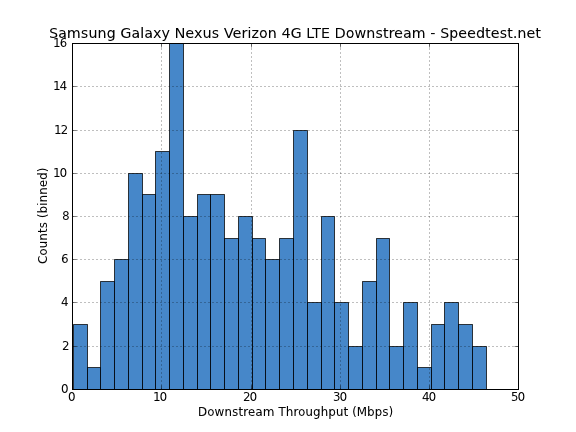
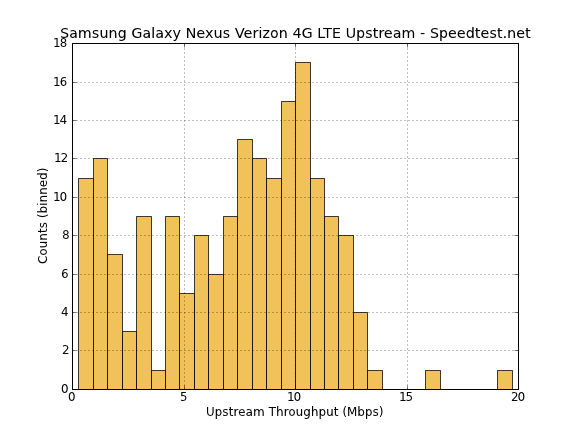
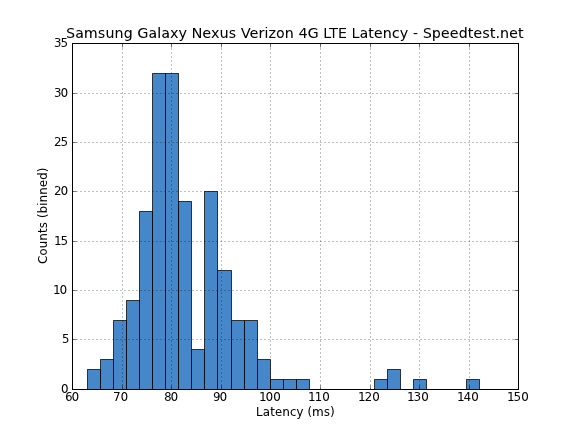
The issue that most people talk about centers around signal strength, and this is where a few misconceptions kick in. I’ve gotten a few emails and tweets and read pages on forums where people are implicitly comparing CDMA2000 1x/EVDO field strength to LTE field strength. The issue here is that on basically all of the LTE/CDMA Verizon handsets, the field under “Signal Strength” in about refers to EVDO signal strength, and not LTE signal strength. The two aren’t comparable at all for a host of reasons - different spectrum (800 MHz and 1900 MHz for 1x/EVDO as opposed to 700 MHz for LTE), and different cells (there’s some correlation, but not every Verizon base station has LTE onboard). The end result is that if you’re comparing 1x/EVDO signal strength to LTE signal strength, you’re making an absolutely meaningless apples to oranges comparison.
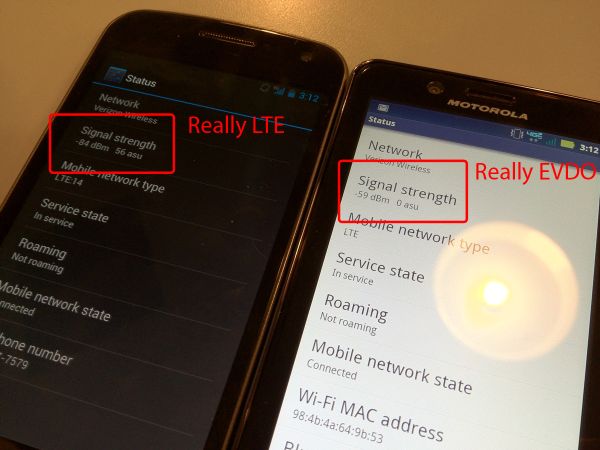
This is not a valid comparison - LTE versus EVDO signal strength
The Galaxy Nexus (and really just Android 4.0) now correctly reports and accommodates LTE by reporting its signal strength under “About->Status” and visualizing that as bars appropriately. Switch to EVDO on the Galaxy Nexus and signal strength appropriately changes to reflect an entirely different air interface’s signal strength. It’s nice to see people using dBm instead of bars when possible (which are effectively meaningless as a comparison metric), but now that there are multiple air interfaces on handsets, we have to be explicit about what numbers we’re actually comparing.
This reporting is a problem I’ve talked about at length in more than one LTE handset review, and to date I only know of ways to show LTE signal strength and channel quality on a few handsets. Samsung’s Droid Charge (courtesy Samsung’s excellent ServiceMode application viewed through *#0011# after some unlock trickery) and the Bionic (through logcat and grepping for the radio signal status daemon) report LTE field strength, but only if you dig for them.
Comparing LTE Signal Strength the Right Way
So how does the LTE Galaxy Nexus compare to the Droid Charge and Bionic, the two handsets we can actually view LTE signal strength in dBm on? Very closely as a matter of fact.
I have a Bionic kicking around which has to go back very soon, but fired up logcat and put the Galaxy Nexus next to it. The Bionic reports signal strength pretty constantly whereas in Android 4.0 the number has some hysteresis, but here the numbers are pretty darn close, with the Bionic hovering between -91 and -95 dBm, and the Galaxy Nexus reporting an average of -92 dBm.
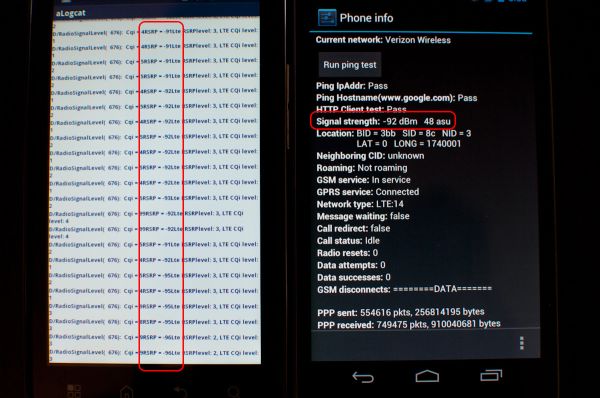
Left: Motorola Droid Bionic (logcat showing LTE signal strength), Right: Galaxy Nexus
Since the Droid Charge is the only other handset I know how to show LTE signal strength on, I tracked a friend down at a local cafe with one and fired up service mode. Again, what’s shown under “About->Status” on the Droid Charge is actually EVDO signal strength. Here the Galaxy Nexus shows -107 dBm and the Droid Charge shows -108 dBm.
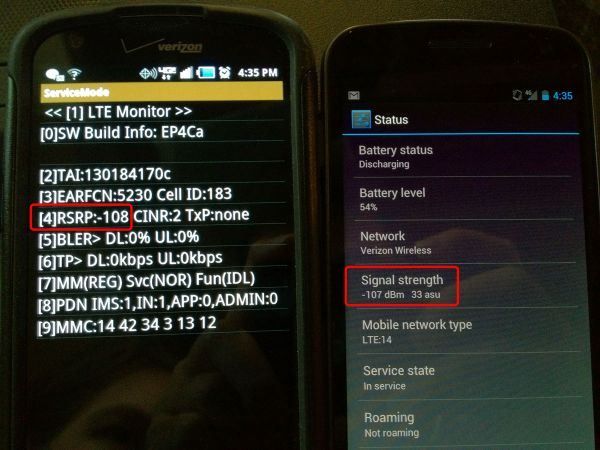
Left: Samsung Droid Charge (ServiceMode) Right: Galaxy Nexus
The Droid Charge is another hilarious example of why you can’t compare bars at all, as the Charge shows a positively laughable 4 out of 5 bars in an area with very low LTE signal strength, whereas the Galaxy Nexus (moreover, Android 4.0) has a very conservative and realistic strength to bars mapping. Carriers love to make things out to be better than they really are, however, and the result is this kind of hilarious visualization which portrays LTE signal as being much better than it really is if you stare at bars all day.
Verizon confirming though a tweet that there’s some sort of signal issue affecting the Galaxy Nexus confuses me, since from my perspective there isn’t any issue at all. The only real issue that exists is that the Galaxy Nexus (and really just the stock Android 4.0 signal strength to bars mapping) doesn’t line up with what Verizon has shipped on other devices, thus leading people to make apples to oranges comparisons and imagine an issue. I wager that some of this confusion is also compounded from the number of Verizon customers that are just now getting their first LTE handset with the Galaxy Nexus. It might be surprising to discover that LTE coverage right now isn't nearly as good as 1x/EVDO, but these things will improve as the carrier's LTE rollout continues. The other big disclamer is that I haven't fully investigated 1x/EVDO performance on the Galaxy Nexus, but this will end up being virtually identical to the Droid Charge.
There’s a CDMA and LTE baseband update coming with the LTE Galaxy Nexus’ 4.0.3 update as shown above, but this will likely do more to address connection stability than change the way anything is reported. Given how much attention this has gotten, however, I would not be surprised to see Google make a change to its signal strength to bars mapping for LTE and placebo away an issue that never really existed to begin with. That's also an unfortunate change, since from my perspective the Galaxy Nexus is one of the first handets that doesn't have an unrealistic mapping. In the meantime, we're still working on our Galaxy Nexus review where we'll take a complete look at the LTE/CDMA and GSM/UMTS Galaxy Nexii.
Update:
As predicted, Verizon has made a statement to The Verge and Computerworld stating that there's nothing wrong with the RF performance characteristics or baseband firmware on the LTE/CDMA Galaxy Nexus. Instead, they will upstream some changes to Android to make the device report its bars visualization in line with the rest of its 4G LTE hardware portfolio.
"[Verizon] will adjust the signal strength indicator to more closely match other Verizon Wireless devices.


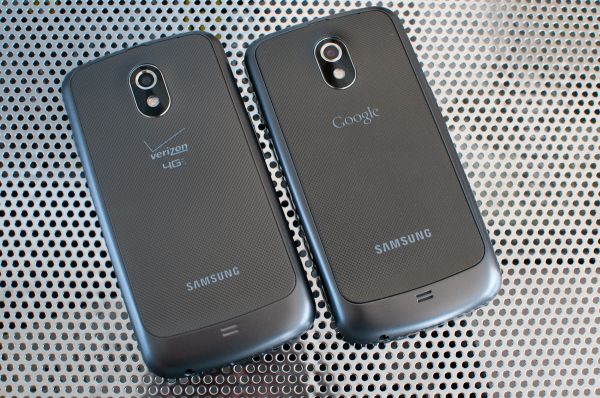









154 Comments
View All Comments
magnimus1 - Tuesday, December 20, 2011 - link
Brian, thanks for the great analysis.I bought a RAZR and Gnex on the 15th. I now understand the fact that I am comparing the dBM wrong.....
HOWEVER.....if that's the case and if the GNex does indeed have a UE category 3, then why do my RAZRs speeds tend to be about consistently 20-30% faster at the same location?
I went back to the Verizon store and compared my dBm to other Nexii in there and I don't think I have a lemon. The dBm values match across Nexii
Do you see a statistical difference in download speeds between the Nexus and a Moto phone as well? Or do your speeds match?
dcdttu - Tuesday, December 20, 2011 - link
After having dropped calls all over Austin and losing signal altogether in areas that other friends have no problems with their Verizon phones, I went to the store to compare my phone to other Verizon LTE enabled Android phones. I noticed that the Nexus was the only phone reporting bars and dBm in LTE and CDMA, according to which it was connected to for data.My coworker has a Charge, and my work is a 3g/4G tower, so I thought I would do a little test there. I put both phones on 3G only and recorded their respective dBm. The Charge showed a signal that was appropriate for being virtually right next to a tower (in the -60's). My Nexus showed a vastly different signal (in the -80s) that would be accurate if the tower were about a mile away even though we were right next to the tower.
I also notice that, out of my 4 friends that have the Nexus (I have an Android group on FB and we're all nerds about it), only 1/2 seem to have the issues I'm having. Everyone else reports fantastic 3G and 4G connectivity. I am meeting up with a friend tomorrow that has a Nexus that doesn't appear to be having the issues mine is for a direct comparison of signal.
But the fact that my phone and friend's Charge show markedly different signals in 3G only tells me something is up. Also, dropping calls everywhere I go, having poor in-call quality and flat losing all service in areas I know to be just fine with other people's phones tells me something is definitely up. Verizon is very good in Austin and I never get above 1-2 bars on my Nexus (yes, I know, they don't mean anything.. but srsly - 2 bars at most all over a large city???)
All of the GN reviews before it launched reported fantastic connectivity and call quality. The reviews such as PC Magizine that were posted after the launch and subsequent 4.0.2 update show issues with reception. I think the 4.0.2 update busted reception for some Nexus devices.
qualm - Tuesday, December 20, 2011 - link
Very interested in your comparison with your friends that has no connectivity problems.Also how is your wifi connection?
dcdttu - Wednesday, December 21, 2011 - link
I just met my friend for lunch. I did a dBm comparison on his phone in 3G only with mine, and they were identical. Then I asked some questions to try to determine why he was having seemingly no issues and I was: he leaves it in 3G. He told me he had left it in 3G the entire time, never putting it on 4G.I had him put it in 4G while we ate, and during that one little hour, his phone failed at sending texts, failed at connecting to 4G and eventually lost signal all together, requiring a reboot.
After the reboot, he had full 4G again like my phone (we were right by a tower) and then both of our phones suddenly had a very bad 4G signal, and then no 4G and they reverted to 3G until we forced a connection with Airplane Mode. Something's definitely up.
There you go.
Also, his phone had the same poor 3G signal mine had. His house isn't good for signal to begin with so he didn't notice between this Nexus and his previous Incredible.
It's my conclusion that all Nexus are having 4G issues as far as connectivity and holding a signal, are having issues switching between 4G and 3G because of authentication or some other problem, and have very poor 3G signal. I do think, however, that the 4G signal seems on par with other phones, minus the issues surrounding the connectivity itself.
dcdttu - Wednesday, December 21, 2011 - link
My wifi connection seems VERY poor. At my friend's house with a brand-new Linksys router, I had to walk to within 10' of the router to get a full signal. At my work in my office, my Evo had a full signal and never dropped Wifi, but my Nexus barely has a signal and drops it all the time.kkwst2 - Wednesday, December 21, 2011 - link
I think it may be quality control. My coworker has a GN and he got reasonable signal (-80's) when I got little to no signal (-120's), both on 4.0.2. So, at least mine is probably a hardware issue. Wouldn't be shocking if there was a manufacturing issue making some of them have poor signal. We'll see what happens when I get my replacement in a couple days...crankerchick - Tuesday, December 20, 2011 - link
Brian I hear you on the apples to apples comparison and agree with all things being equal, performance is the same. My example is I lined up the Droid Charge, Galaxy Nexus, Razr, and Rezound all in the same orientation in the Verizon store and did a speed test and also looked at signal strength. The Galaxy Nexus of course reported much weaker signal (-100 dBm) while the others all reported stronger signals (-70 dBm). The Galaxy Nexus was reporting 2 bars of signal while the others reported 3, sometimes 4, bars. However, with speed test performed 5 times on each device, the data speeds and ping were all within 1 Mbps of each other. This is what really left me feeling comfortable to go ahead and trade in my Rezound for the Nexus. I felt that as long as my data speeds were comparable to the Rezound then I could live with whatever issue there may or may not be until a "fix" is released.My biggest worry was and still remains how the Nexus will perform in fringe areas. So far, my only data point is my office, where my service is pretty bad. My original Droid struggled to maintain 3G at this location. The Rezound was a champ and could hold 4G and pull 5-6 Mbps speeds but he Galaxy Nexus won't even lock to 4G at all, let alone stay connected.
The Rezound in my experience after a month with the phone holds a 4G signal much better than the Nexus and also handles the handoff between 3G and 4G better.
I hope your review will include tests performed in areas of weaker 4G and compare to other devices so that your readers can have the full picture of the performance of this (and other) devices. It's not enough to say the devices performs as others unless, as you said, you do an apples to apples comparison, which would include detailing how well they perform under different situations, not just when the 4G signal is strong.
freestylee30 - Tuesday, December 20, 2011 - link
Maybe I'm not reading this right or not fully understanding, but your article doesn't explain my experience with the phone (as limited as it is)...(In Seattle) I'm in a Verizon store, they have all the 4G LTE phones lined up and their Galaxy Nexus is the ONLY one with 2 bars... Everything else has 4. I wasn't convinced this was a huge issue so I ran speedtests multiple times on the GN and the Razr... Consistently the GN was in the ~5 Mb range (download) and the Razr was 15+.
If this isn't a real problem then how do you justify the speed differences? I also rebooted the GN thinking it might help. No luck.
The GN was on 4.0.2. My contract is up December 22nd and I'm trying to find my next phone =((
Brian Klug - Tuesday, December 20, 2011 - link
The bars comparison is the problem there - these aren't standardized at all and aren't useful for comparing reception at all. I can't speak for why throughput would be so much different between the two in the store, but what testing I've done so far seems to put the GN in front of other UE Category 2 devices.-Brian
freestylee30 - Tuesday, December 20, 2011 - link
Obviously I just looked at the "bars" but if I had access to the actual signal and saw some fairly large discrepancy (20 dbm? - not sure what one would consider "fairly large") would that explain the throughput problem I saw?Also, Brian or anyone else that likes to share their opinion - with Verizon's current Android 4G LTE lineup, which phone would you choose?
Thanks!